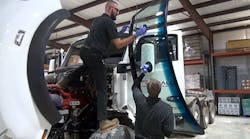Exposure to vehicle exhaust fumes can have immediate health effects including irritating the eyes, nose, throat and lungs. They can cause coughs, headaches, lightheadedness, nausea and difficulty breathing.
Longer term, and consequently not as readily apparent, without control and removal of vehicle exhaust fumes, exposed workers face increased health risks, which include respiratory disease and cancer.
Even though vehicle engines may only run a short time indoors, even with shop doors open, exhaust can build up in the building.
FUELS
The number one source of carbon monoxide – odorless, colorless gas – is gasoline engine exhaust fumes. It is harmful when breathed in because it displaces oxygen in the blood and deprives the heart, brain and other vital organs of oxygen. Large amounts of carbon monoxide can overcome a person in minutes, causing them to lose consciousness and suffocate.
Diesel exhaust is a mixture of gases and fine particulates (commonly known as soot) produced during the combustion of diesel fuel. More than 40 substances emitted in diesel exhaust are listed as hazardous air pollutants. These include many known or suspected cancer-causing substances, such as benzene, arsenic, benzo(a)pyrene and formaldehyde.
In addition to causing worker health issues, without control and removal of the vehicle exhaust fumes, high-tech electronics of diagnostic and servicing equipment may be damaged and more shop maintenance may be required due to soot build up.
Cleaning vehicle exhaust fumes provides a healthier, more pleasant working atmosphere.
EXTRACTION METHODS
There are a number of ways to lessen or eliminate exposure to vehicle exhaust fumes, says Kerry Falzone, marketing manager, business unit exhaust extraction, Plymovent Corp. (www.plymovent.com), a global supplier of products, systems and services for the extraction and filtration of polluted indoor air. The more common methods are:
- General Ventilation – This involves opening a shop’s doors or using a large wall or roof fan to move air through the facility, thus lowering the concentration of exhaust fumes within it.
“The problem with general ventilation, especially in colder areas of the country, are high heating costs and uncomfortable working conditions where large volumes of air are moved through the building,” she explains. “Plus, you are still being exposed to the hazardous fumes.”
- Air Cleaners – These are used to clean and circulate “polluted” air around within the shop.
Air cleaners “can clean and strip particles from the air stream,” says Falzone, but even with air cleaners with carbon filtration cells, “there is the probability hazardous gases can still pass through, especially if the carbon cells are saturated.”
Another downside of air cleaners is that everyone is exposed to the fumes, she says. While the air cleaners are located several feet above the top of the vehicles, exhaust fumes generally are exhausted at or near floor level, so anyone within the facility is exposed to the fumes before they can be filtered.
She adds that another drawback is that constant maintenance is necessary to assure the media filters and carbon cells are doing their job.
- Source Capture – This is the preferred method to capture and remove automotive and diesel exhaust fumes because it is more effective, observes Falzone. “With a direct connection to the vehicle tailpipe, a hose capture system becomes an extension of the tailpipe, collecting the hazardous fumes prior to their spreading into the shop and conveying them to the outside of the facility.”
Along with capturing the fumes, only a small volume of shop air is collected and expelled, thus lowering the need for large air make-up units, she notes.
FANS
All three vehicle exhaust extraction methods employ the use of a fan, but in different ways.
General ventilation systems use large propeller fans, Falzone explains. These can be direct drive or belt-driven, depending on the size of the fans. These systems move large volumes of air through large wall or roof openings where there is little resistance to the airflow.
Air cleaners usually have a belt-driven fan utilizing a forward curved impeller. These are similar to a fan used in a forced hot air home furnace where large airflows are required with a relatively small amount of resistance and quiet operation, she says.
Source capture exhaust systems generally always use a radial or backward inclined impeller fan operating at high speed. The fans, which can be belt-driven or direct drive, can generate the necessary higher static pressure required to draw the exhaust fume up through the system’s exhaust hoses and metal ductwork, she says.
Most source capture systems move the exhaust fumes through the hoses and ductwork at velocities in the 3,000 to 4,000 feet per minute range.
CHECKLIST
When looking to acquire a vehicle exhaust capture system, Falzone offers some advice:
- Consider what types of operations occur within the facility.
+ Do vehicles drive in through a shop door and park immediately for servicing?
+ Do the vehicles enter through the door, drive through the facility and then into service bays?
+ Are vehicle engines operated for a long period of time, at high rpms, under loads, etc.?
- Don’t overlook operator acceptance, usage and the periodic maintenance of the system. The best exhaust system in the world is of little benefit if it isn’t used, is used incorrectly or is not maintained properly, she says.
There are numerous other considerations that go into the design of a vehicle exhaust removal system. A best practice is to seek guidance and counsel from system manufacturers and suppliers.




